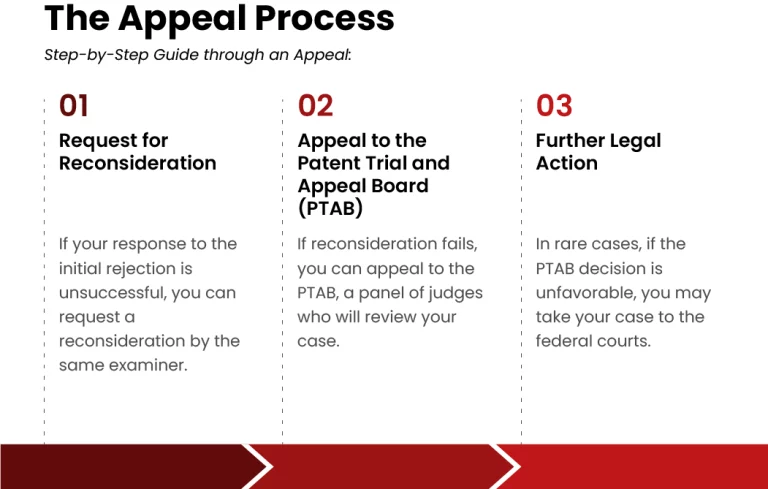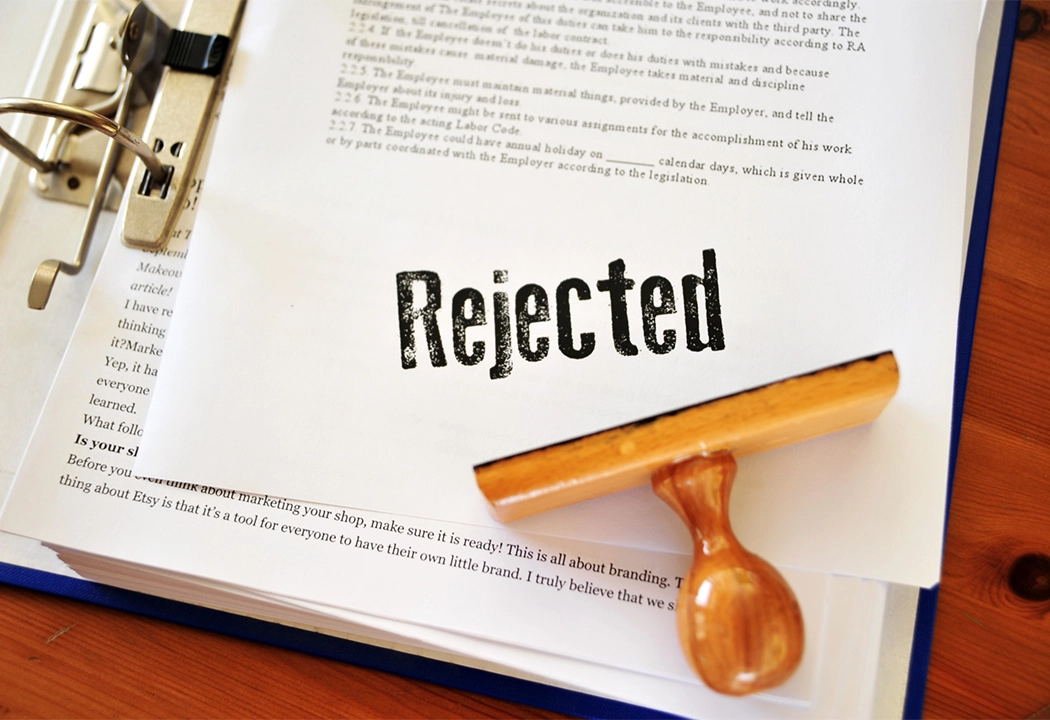Introduction
Navigating the world of patents can be a daunting journey, especially for first-time applicants. You’ve spent countless hours refining your invention, meticulously preparing your application, and then, you receive a notice of rejection from the patent office.
It’s a scenario many inventors face, yet it often comes as an unexpected setback. However, it’s crucial to understand that a first-time rejection is not the end of the road but a common step in the patent acquisition process.
Statistics reveal that initial rejections are more the norm than the exception. In the United States, for instance, the United States Patent and Trademark Office (USPTO) initially rejects the majority of applications. But this is not a definitive denial.
Instead, it’s a part of a broader, iterative process of refining and negotiating your claim to fit within the legal framework of patent law.
This comprehensive guide aims to demystify the first-time patent rejection, providing you with actionable strategies, emotional support, and a roadmap to turning that rejection into an eventual approval.
Remember, many of today’s groundbreaking inventions were initially rejected, only to become success stories through perseverance and strategic response.
Table of Contents
Understanding Patent Rejection
What Does Patent Rejection Mean?
A patent rejection is a formal notice from a patent office indicating that your application does not meet certain criteria necessary for granting a patent. It’s important to note that this is often not an outright denial but rather a communication that aspects of your application need revision or clarification.
Types of Patent Rejections
- Substantive Rejections: These are based on the content of your invention. Common reasons include:
- Lack of Novelty
In patent terms, novelty means that the invention has not been previously made public in any form before the date of the patent application. It’s one of the most common grounds for rejection.
To overcome this, you must demonstrate that your invention is distinctly different from all previously disclosed inventions (known as ‘prior art’). This might involve highlighting unique features or functionalities that set your invention apart. - Non-Obviousness
This criterion addresses whether the invention is an obvious development for someone with standard knowledge in the field. To counter a rejection based on non-obviousness, you should illustrate the unexpected benefits or surprising elements of your invention.
This could involve providing evidence of how your invention solves a problem in a way that wasn’t obvious before. - Inadequate Disclosure
A patent application must fully disclose the invention in a way that allows others in the field to replicate it. If a rejection cites inadequate disclosure, it means the examiner believes your description is too vague or incomplete.
To rectify this, provide more detailed descriptions, diagrams, and explanations, ensuring that every aspect of your invention is clearly and comprehensively articulated.
2. Procedural Rejections: These occur due to issues in the application process, like improper formatting or missing documents.
- Impact of Global Patent Laws
Different countries have varying standards for what constitutes novelty, non-obviousness, and adequate disclosure. For instance, the European Patent Office (EPO) might have different criteria or interpretations compared to the USPTO.
It’s important for inventors filing internationally to understand these nuances. Tailoring your application to meet the specific requirements of each patent office can greatly increase your chances of approval.
Common Reasons for Rejection
- Prior Art Issues: Your invention overlaps significantly with existing patents or published material.
- Technicalities: Errors in the application, such as incorrect terminology or inadequate drawings.
- Scope of Claims: Overly broad or unclear claims that do not define the specific boundaries of the invention.
Immediate Steps After Rejection
- Detailed Analysis of a Rejection Notice
A typical rejection notice from the USPTO will include specific references to the claims that are being rejected and the reasons why. It will often cite prior art or specific legal statutes that the application is allegedly infringing upon. Understanding each point of contention is crucial for crafting an effective response. - The Importance of a Timely Response
Responding to a patent rejection in a timely manner is crucial. In the U.S., you generally have three months from the date of the rejection notice to respond, with the possibility of extending this to six months for additional fees. Delaying beyond this period can lead to the abandonment of your application.
Analyzing the Examiner’s Objections
Break Down the Objections
Examine each objection or rejection reason individually. Understanding the examiner’s perspective can provide insights into how you might modify your application or argue against the rejection.
Seeking Professional Help
Consider consulting with a professional consulting firm. These professionals can provide valuable insights into the complexities of patent law and help craft a more persuasive response.
Addressing Prior Art
If your rejection involves prior art, you may need to distinguish your invention more clearly from the cited references. This might involve amending claims or providing a more detailed explanation of how your invention is different.
Crafting a Response Strategy
Responding to Different Types of Rejections
- Substantive Rejections: Focus on amending your claims to overcome issues like lack of novelty or non-obviousness.
- Procedural Rejections: Correct any errors or omissions as pointed out by the examiner.
Importance of Amendments and Arguments
- Amendments: Changing the wording of your claims can help clarify your invention and its novel aspects.
- Arguments: Present well-reasoned arguments as to why your invention is patentable despite the examiner’s concerns.
Crafting a Response Strategy
Techniques for Amending Claims
When amending claims, focus on narrowing their scope to avoid overlapping with prior art while still covering the core aspects of your invention. Use precise, technical language and avoid broad or ambiguous terms.
For instance, if your invention is a new type of battery, specify the unique chemical composition or design features that set it apart from existing batteries.
Argumentation Skills
Developing strong argumentation skills is key. This involves presenting logical, well-structured arguments that directly address the examiner’s concerns. Use evidence, such as experimental data or technical comparisons, to support your arguments.
It’s also effective to reference previous patents or legal precedents that align with your case.
The Appeal Process
Understanding the Appeal Process
If your response to the rejection doesn’t lead to approval, an appeal might be your next step. This involves a review of your case by a different set of examiners or a patent trial and appeal board.

The Appeal Process
Step-by-Step Guide through an Appeal:
- Request for Reconsideration: If your response to the initial rejection is unsuccessful, you can request a reconsideration by the same examiner.
- Appeal to the Patent Trial and Appeal Board (PTAB): If reconsideration fails, you can appeal to the PTAB, a panel of judges who will review your case.
- Further Legal Action: In rare cases, if the PTAB decision is unfavorable, you may take your case to the federal courts.
Alternative Strategies
Re-filing the Application
If the original application has fundamental flaws, re-filing might be a viable option. This means starting the process anew, but with the benefit of understanding the reasons for the initial rejection.
Pursuing a Provisional Patent
For some inventors, converting the application into a provisional patent can provide additional time to refine the invention or strategy. This can also be a cost-effective way to maintain a filing date.
Continuation Applications
These allow you to pursue additional claims based on the same invention disclosed in the original application. If your initial application faced rejection due to certain claims, a continuation application can help you protect other aspects of your invention.
Divisional Applications
If the examiner deemed your original application to contain multiple inventions, a divisional application allows you to split these into separate applications. This can be a strategic way to ensure that while one part faces rejection, other aspects of your invention still get patented.
Utility Patents
These are the most common, protecting the function of an invention. If your utility patent faces rejection, consider whether a different aspect of your invention is patentable.
Design Patents
If your invention has a unique aesthetic or ornamental design, a design patent might be a viable alternative. Design patents are often easier to obtain and can provide significant protection.
International Patent Strategies
- If you face challenges patenting your invention in one country, consider the potential in other markets. Patent laws and the likelihood of obtaining a patent can vary significantly from country to country.
- Explore the Patent Cooperation Treaty (PCT) as a way to file internationally, potentially opening up broader markets for your invention.
Pros and Cons
Each alternative path has its advantages and drawbacks. Re-filing might mean losing the original filing date, while provisional patents require a follow-up non-provisional application within a year.
Learning and Moving Forward
Learning from Rejection
Each rejection provides valuable feedback. Use this as a learning opportunity to refine your approach to patent applications and understand the patent system better.
Keeping Up to Date
Stay informed about changes in patent laws and trends. This knowledge can be crucial for future applications and for understanding the reasons behind rejections.
Preparing for Future Applications
Use the experience gained from this process to improve future patent applications. Each interaction with the patent office is an opportunity to gain insights into what is required for a successful patent grant.
Conclusion
While a first-time patent rejection can be discouraging, it’s a normal part of the patent acquisition process and not an insurmountable barrier. By understanding the reasons behind the rejection, crafting a strategic response, and remaining resilient, inventors can significantly increase their chances of eventual success. Remember, the journey of patenting is often as intricate and innovative as the inventions themselves.
About TTC
At TT Consultants, we're a premier provider of custom intellectual property (IP), technology intelligence, business research, and innovation support. Our approach blends AI and Large Language Model (LLM) tools with human expertise, delivering unmatched solutions.
Our team includes skilled IP experts, tech consultants, former USPTO examiners, European patent attorneys, and more. We cater to Fortune 500 companies, innovators, law firms, universities, and financial institutions.
Services:
- Patentability Search
- Invalidation Search
- Freedom to Operate (FTO) Analysis
- Patent Portfolio Management
- Patent Infringement Searches
- Drafting & Illustrations
- Competitive Benchmarking
- Technology Scouting
- Landscape Analysis
- Whitespace Analysis
- Business Research
Choose TT Consultants for tailored, top-quality solutions that redefine intellectual property management.
Contact Us



